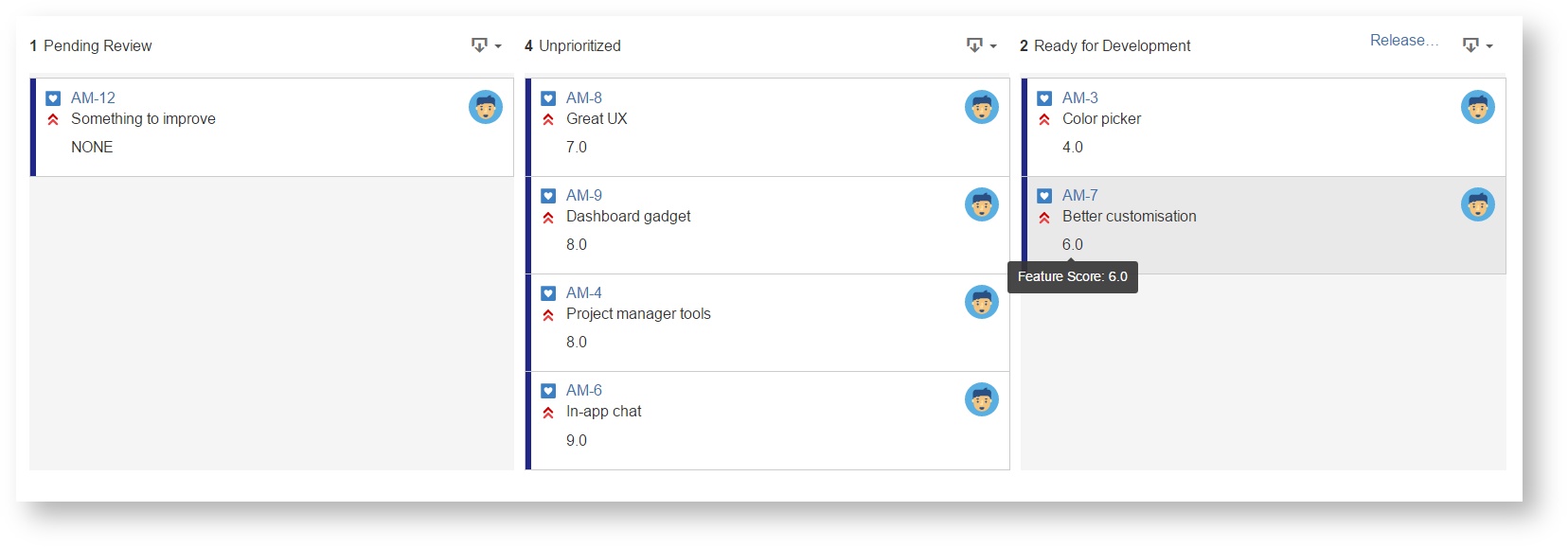Product backlog with Demand, Impact, Effort
On this page, we will show you how we handle and prioritize the feature requests, ideas and other tasks with the Issue Score add-on.
Collecting feedback
We distinguish feedbacks, ideas, and proposals with different issue types from the developer tasks. We create Idea type of Issue from all internal proposal, and they are usually treated as a lower priority task.
Boards
In our company, many projects are running and we use different methodologies for them. We are old friends with Scrum, and it's a perfect framework for customer projects. However, for our add-on development projects, we chose the Kanban system.
Using Kanban system, we are not tied to strict deadlines, as in the case of the scrum. We can plan flexible and release fast, as it is great for continuous delivery with changing priorities. Variable team size will also benefit from this system, after all, sometimes resources should be reallocated elsewhere. With the kanban board, the team is able to track the progress of work through its workflow in a highly visual manner.
We use two kanban board: one as the backlog of the product, one as a traditional development board.
Product Backlog
After reading Dan Radigan's blogpost at Atlassian Blogs, we created a dedicated kanban board with a special workflow for user feedback. This way, the product owner is free to review, specify and prioritize work in the backlog without ever disrupting the team. Every feedback, feature request, improvement proposal is here until it travels through the board and the associated workflow.
As the JIRA team, we use a three-tier backlog to review each piece of feedback.
The product backlog has three states:
- Pending review: Raw feedback. In this state, the product owner inspects and decides whether to keep or pass it.
- Unprioritized: Committed to the backlog, but not ready for development.
- Ready for development: The feature is specified and can be worked on. From this ordered column the product owner can quickly pull and convert tasks to the Developer board.
If the Ready for development queue gets low, the product owner can pull items from the Unprioritized column, etc.
Using this system makes it a lot easier to manage and prioritize user feedback. But figuring out what build next may be still one of the hardest decisions for the product owner. In general, we rely on our instincts because we can not rely on real numbers.
This is where Issue Score can really help you!
Our add-on will help you to build a product pipeline with prioritized features based on your key business metrics. You can easily set your key parameters to rank your features and get your scores. This score point will determine the value of your feature, and you can prioritize them based on it. Let me show you how it works based on Josh Pigford's DIE: Demand, Impact, Effort framework, what we really like.
The DIE is a simple scoring system that guides product managers what features to build next. You rank your features with three parameters and the result of those ratings is a score where the lower the number, the more important the feature is. As Josh said: "The goal of this is not to create something that categorically makes decisions for you or to somehow quantify exactly how much business impact this will make so that you can’t screw things up."
The three parameters:
- Demand: "Demand is how much your customer base and target market wants the feature."
- Impact: "It’s the thing you want to affect."
- Effort: "How much work will this feature require."
You can create Key-Value fields as options and values for each parameter, eg. High option with a value of 1. This way you can evaluate each feature individually and get the scores.
With Issue Score, you can immediately see your feature's value on the Issue screen. Being a simple custom field means, that you can add to every screen where you want to see the score.
In our case, I want to see the scores on the product backlog kanban board, and prioritize features and tasks based on them. As you can see in the screenshot above, this is really easy to do.
I review every raw feedback, and if it's relevant, I set the parameters and move the Issue to the Unprioritized column. In this case, I set the Demand value based on how many related requests were received. The Impact value is always determined by the current business and/or product strategy.
One of the great features of JIRA is that if you do not want to manually sort the Issues on the board, it is enough to set the order in the filter, eg. project = AM AND issuetype = Feedback ORDER BY "Issue Score". In this case, your feature order is tied to real numbers every time you look at it.
If you enjoyed this article, try out Issue Score now!
